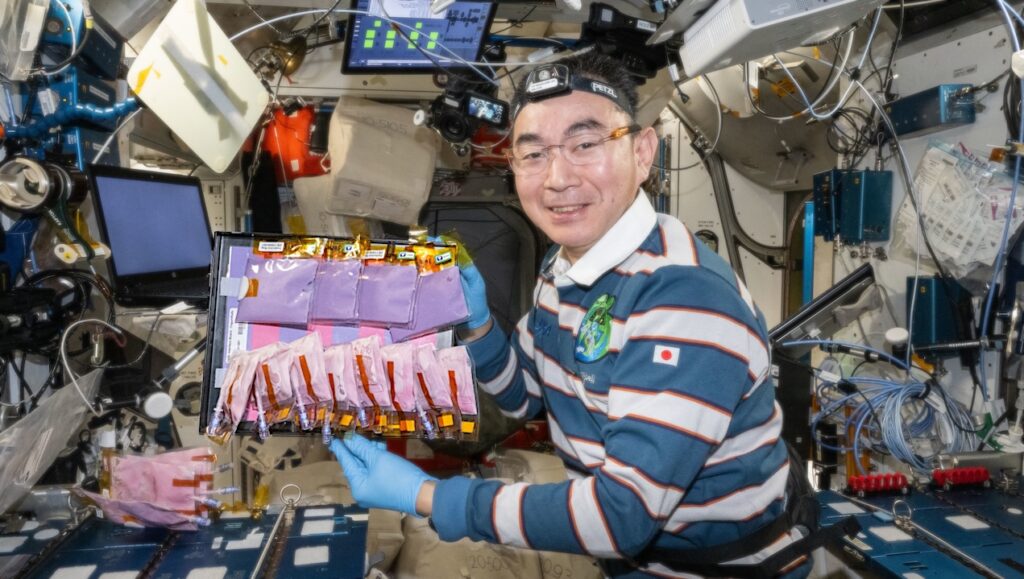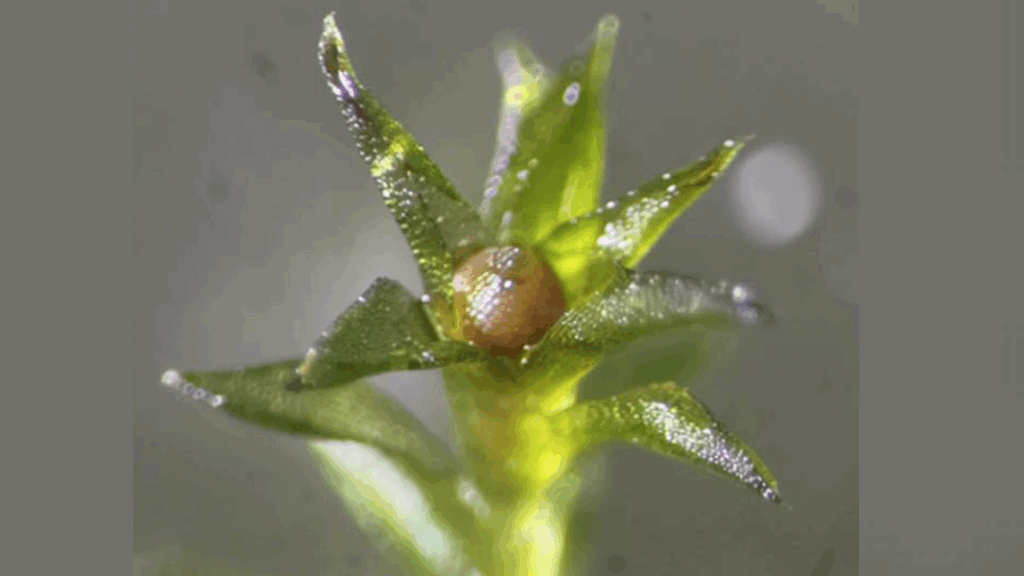NASA Spaceline Current Awareness List #1,083 – 19 January 2024 (Space Life Science Research Results)

Astronaut Thomas Pesquet works on the Cardinal Muscle investigation in the Life Sciences Glovebox aboard the International Space Station. Credits: NASA
SPACELINE Current Awareness Lists are distributed via listserv and are available on the NASA Task Book website at https://taskbook.nasaprs.com/Publication/spaceline.cfm. Please send any correspondence to Shawna Byrd, SPACELINE Current Awareness Senior Editor, [email protected].
Call for articles to cite in the weekly lists: Authors at NASA Centers and NASA PIs—do you have an article that has recently published or will publish in the upcoming weeks within a peer-reviewed journal and is in the scope of space life sciences? If so, send it our way! Send your article to the email address mentioned above. Articles received by Wednesday will appear within that week’s list—articles received after Wednesday will appear the following week.
Papers deriving from NASA support:
- Buchheim J-I, Feuerecker M, Balsamo M, Vukich M, Van Walleghem M, Tabury K, Quintens R, Vermeesen R, Baselet B, Baatout S, Rattenbacher B, Antunes I, Ngo-Anh TJ, Crucian B, Choukér A.Monitoring functional immune responses with a cytokine release assay: ISS flight hardware design and experimental protocol for whole blood cultures executed under microgravity conditions.Front Physiol. 2024 Jan 15;14:1322852.Note: This article is part of Research Topic “Community Series in Deciphering Immune and Neuroendocrine Crosstalk in Extreme Environments: Volume II” (https://www.frontiersin.org/research-topics/45896/community-series-in-deciphering-immune-and-neuroendocrine-crosstalk-in-extreme-environments-volume-ii#overview). This article may be obtained online without charge.
Journal Impact Factor: 4.0
Funding: “This work has been supported by the DLR on behalf of the Federal Ministry of Economics and Technology (BMWi 50WB0719 and 50WB0919, 50WB1319, 50WB2222, 50WB2026), the European Space Agency (ESA) (ELIPS 3 and 4, and SciSpacE programs) as well as the Belgian Science Policy Office [BELSPO/ESA PRODEX grant numbers PEA_4000140806 and CO-90-11-2801-04 (IMPULSE)] and by the Medical and Clinician Scientist Program (MCSP) of the LMU Munich, Germany. Initial development of the whole blood assay and prototype flight hardware was funded by the NASA Johnson Space Center, Human Research Program, Human Health and Countermeasures Element.” - Voss AC, Chambers TL, Gries KJ, Jemiolo B, Raue U, Minchev K, Begue G, Lee GA, Trappe TA, Trappe SW.Exercise microdosing for skeletal muscle health applications to spaceflight.J Appl Physiol (1985). 2024 Jan 11. Online ahead of print.Note: From the abstract: “Findings from a recent 70 day bedrest investigation suggested intermittent exercise testing in the control group may have served as a partial countermeasure for skeletal muscle size, function, and fiber-type shifts. The purpose of the current study was to investigate the metabolic and skeletal muscle molecular responses to the testing protocols.”
Journal Impact Factor: 3.3
Funding: “NNX11AJ62G/National Aeronautics and Space Administration (NASA).” - Afshari N, Koturbash I, Boerma M, Newhauser W, Kratz M, Willey J, Williams J, Chancellor J.A review of numerical models of radiation injury and repair considering subcellular targets and the extracellular microenvironment.Int J Mol Sci. 2024 Jan 13;25(2):1015. Review.PI: J. ChancellorNote: This article is part is Special Issue “Radiation-Induced Non-DNA-Targeted Effects Relevant to Radiation Protection and Medicine” (https://www.mdpi.com/journal/ijms/special_issues/non_DNA_radiation). Additional articles will be forthcoming and may be found in the link to the Special Issue. This article may be obtained online without charge.
Journal Impact Factor: 5.6
Funding: “This review was funded by National Aeronautics and Space Agency (NASA), grant number 80NSSC21K0544. J.C. and N.A. also acknowledge support from LaSPACE through NASA, grant number 80NSSC20M0110.” - Perdyan A, Jąkalski M, Horbacz M, Beheshti A, Mieczkowski J.Chromosomal positioning and epigenetic architecture influence DNA methylation patterns triggered by galactic cosmic radiation.Sci Rep. 2024 Jan 15;14(1):1324.Note: This article may be obtained online without charge.
Journal Impact Factor: 4.6
Funding: A. Beheshti is affiliated with NASA Ames Research Center. - Chinnannan K, Somagattu P, Yammanuru H, Nimmakayala P, Chakrabarti M, Reddy UK.Effects of Mars Global Simulant (MGS-1) on growth and physiology of sweet potato: A space model plant.Plants. 2024;13(1):55.Note: This article is part of Section “Plant Physiology and Metabolism” (https://www.mdpi.com/journal/plants/sections/Plant_Physiology_Metabolism) and may be obtained online without charge.
Journal Impact Factor: 4.5
Funding: “The authors thank NASA WV EPSCoR (NASA-EPSCoR-R3-21-0051) for their financial support.” - Hayat F, Deason JT, Bryan RL, Terkeltaub R, Song W, Kraus WL, Pluth J, Gassman NR, Migaud ME.Synthesis, detection, and metabolism of pyridone ribosides, products of NAD overoxidation.Chem Res Toxicol. 2024 Jan 10.PI: M.E. MigaudJournal Impact Factor: 4.1
Funding: “This work (Project #T0702) is supported by the Translational Research Institute for Space Health through NASA Cooperative Agreement NNX16AO69A.”
Other papers of interest:
- Aniskina TS, Sudarikov KA, Levinskikh MA, Gulevich AA, Baranova EN.Bread wheat in spaceflight: Is there a difference in kernel quality?Plants (Basel). 2023 Dec 25;13(1):73.Note: ISS results. This article is part is Special Issue “Effects of the Extraterrestrial Environment on Plants” (https://www.mdpi.com/journal/plants/special_issues/extraterrestrial_plants). The Special Issue also includes an article from previous Current Awareness List #1,061 https://doi.org/10.3390/plants12142628. This article may be obtained online without charge.
- Mahmood R, Shaik T, Kaur IP, Gupta V, Shaik A, Anamika F, Garg N, Jain R.Cardiovascular challenges beyond Earth: Investigating the impact of space travel on astronauts’ cardiovascular health.Cardiol Rev. 2024 Jan 17. Review. Online ahead of print.Note: From the abstract: “Understanding the risks to the heart and blood circulation brought on by exposure to space radiation and the overall stress of spaceflight is essential and this article reviews the cardiovascular effects of space travel on astronauts.”
- Mastrandrea CJ, Greaves DK, Shoemaker JK, Blaber AP, Arbeille P, Hughson RL.Lower body negative pressure identifies altered central vein characteristics without accompanying changes to baroreflexes in astronauts within hours of landing.Sci Rep. 2024 Jan 12;14:1215.Note: From the Methods section: “Testing was performed at either the Johnson Space Center (Houston, TX), Kennedy Space Center (Cape Canaveral, FL), Dryden Flight Research Center (Edwards, CA), or Gagarin Cosmonaut Training Center (Star City, Russia) depending on mission parameters. Preflight data were collected approximately 30-days before launch. Four of the astronauts launched aboard the space Shuttle, and three launched on the Soyuz.” This article may be obtained online without charge.
- Frossard E, Crain G, de Azcárate Bordó ns I, Hirschvogel C, Oberson A, Paille C, Pellegri G, Udert KM.Recycling nutrients from organic waste for growing higher plants in the Micro Ecological Life Support System Alternative (MELiSSA) loop during long-term space missions.Life Sci Space Res. 2024 Feb;40:176-85.
- Zhao L, Li Z, Huang B, Mi D, Xu D, Sun Y.Integrating evolutionarily conserved mechanism of response to radiation for exploring novel Caenorhabditis elegans radiation-responsive genes for estimation of radiation dose associated with spaceflight.Chemosphere. 2024 Jan 9:141148.
- Ahn JH, Park S, Hwang YM, Choi YS, Yi JW.Morphologic and genomic changes of thyroid cancer cell lines exposed to conditions of simulated microgravity.npj Microgravity. 2024 Jan 15;10:8.Note: From the abstract: “Microgravity in space impacts human health. In particular, thyroid cancer, which has a high incidence rate, has been the subject of numerous studies with respect to microgravity. However, most studies have focused on Western follicular thyroid cancer cell lines, while data regarding the effects of microgravity on Asian cell lines are lacking. Therefore, we aimed to investigate the effect of simulated ground-based microgravity on two Korean thyroid cancer cell lines, namely SNU-790 and SNU-80.” This article may be obtained online without charge.
- Caddy HT, Kelsey LJ, Parker LP, Green DJ, Doyle BJ.Modelling large scale artery haemodynamics from the heart to the eye in response to simulated microgravity.npj Microgravity. 2024 Jan 13;10(1):7.Note: This article may be obtained online without charge.
- Grassi M, Von Der Straten F, Pearce C, Lee J, Mider M, Mittag U, Sies W, Mulder E, Daumer M, Rittweger J.Changes in real-world walking speed following 60-day bedrest.npj Microgravity. 2024 Jan 13;10:6.Note: Bedrest study. This article may be obtained online without charge.
- Guillaud E, Leconte V, Doat E, Guehl D, Cazalets JR.Sensorimotor adaptation of locomotor synergies to gravitational constraint.npj Microgravity. 2024 Jan 11;10(1):5.Note: From the abstract: “This study investigates the impact of gravity on lower limb muscle coordination during pedaling. It explores how pedaling behaviors, kinematics, and muscle activation patterns dynamically adapts to changes in gravity and resistance levels. The experiment was conducted in parabolic flights, simulating microgravity, hypergravity (1.8 g), and normogravity conditions.” This article may be obtained online without charge.
- Kang L, Li Q, Jing Y, Ren F, Li E, Zeng X, Xu Y, Wang D, Wang Q, Sun G, Wei L, Diao Y.Auricularia auricula anionic polysaccharide nanoparticles for gastrointestinal delivery of Pinus koraiensis polyphenol used in bone protection under weightlessness.Molecules. 2024 Jan 2;29(1):245.Note: This article is part is Special Issue “Nanomedicine: Applications and Development Prospects” (https://www.mdpi.com/journal/molecules/special_issues/M3B797ZT73). Additional articles will be forthcoming and may be found in the link to the Special Issue. This article may be obtained online without charge.
- Kermorgant M, Chedmail T, Varenne F, Bareille MP, Beck A, Billette de Villemeur R, Fournié P, Grondin L, Hélissen O, Membrives C, Nasr N, Pavy-Le Traon A, Soler V.Neuro-ophthalmological changes in healthy females exposed to a 5-day dry immersion: A pilot study.npj Microgravity. 2024 Jan 11;10:4.Note: This article may be obtained online without charge.
- Leuti A, Fava M, Pellegrini N, Forte G, Fanti F, Della Valle F, De Dominicis N, Sergi M, Maccarrone M.Simulated microgravity affects pro-resolving properties of primary human monocytes.Cells. 2024 Jan 3;13(1):100.Note: The rotary cell culture system was used in this study. This article is part of Special Issue “New Insights into Microgravity and Space Biology” (https://www.mdpi.com/journal/cells/special_issues/R75D12X7FZ). The Special Issue also includes articles from previous Current Awareness Lists #1,028 https://doi.org/10.3390/cells11233871; #1,032 https://doi.org/10.3390/cells12020246; #1,041 https://doi.org/10.3390/cells12050691 and https://doi.org/10.3390/cells12050734;#1,061 https://doi.org/10.3390/cells12141907; #1,064 https://doi.org/10.3390/cells12162106; and #1,072 https://doi.org/10.3390/cells12202470. This article may be obtained online without charge.
- Verbeelen T, Fernandez CA, Nguyen TH, Gupta S, Aarts R, Tabury K, Leroy B, Wattiez R, Vlaeminck SE, Leys N, Ganigué R, Mastroleo F.Whole transcriptome analysis highlights nutrient limitation of nitrogen cycle bacteria in simulated microgravity.npj Microgravity. 2024 Jan 10;10:3.Note: The rotary cell culture system was used in this study. This article may be obtained online without charge.
- Wang M, Chen S, Zhong C, Liu L, Wang G, Huang X, Yang X, Yang H, Li L.The influence of simulated weightlessness on the composition and function of gut microbiota and bile acid metabolism products.Life Sci Space Res. 2024 Jan 14. Online ahead of print.
- Xie Y, Fu Y, Shao Y, Qu L, Yang J, Yang C, Zhou K, Li K, Xu Z, Xu D, Cao K, Tian N, Lv K, Wang L, Wang Y, Wang N, Li Y.Quantitative ultrasound image assessment of the optic nerve subarachnoid space during 90-day head-down tilt bedrest.npj Microgravity. 2024 Jan 17;10(1):9.Note: This article may be obtained online without charge.
- Zhao Z, Wang X, Ma Y, Duan X.Atp6v1h deficiency blocks bone loss in simulated microgravity mice through the Fos-Jun-Src-Integrin pathway.Int J Mol Sci. 2024 Jan 4;25(1):637.Note: Hindlimb unloading study. This article is part of Special Issue “Ion Pumps: Molecular Mechanisms, Structure, Physiology” (https://www.mdpi.com/journal/ijms/special_issues/845Y4283W3) and may be obtained online without charge.
- Shama S, Ranade AV, Qaisar R, Khan NA, Tauseef I, Elmoselhi A, Siddiqui R.Enhancing microbial diversity as well as multi-organ health in hindlimb unloaded mice.Life Sci Space Res. 2024 Feb;40:62-71.Note: Hindlimb unloading study.








